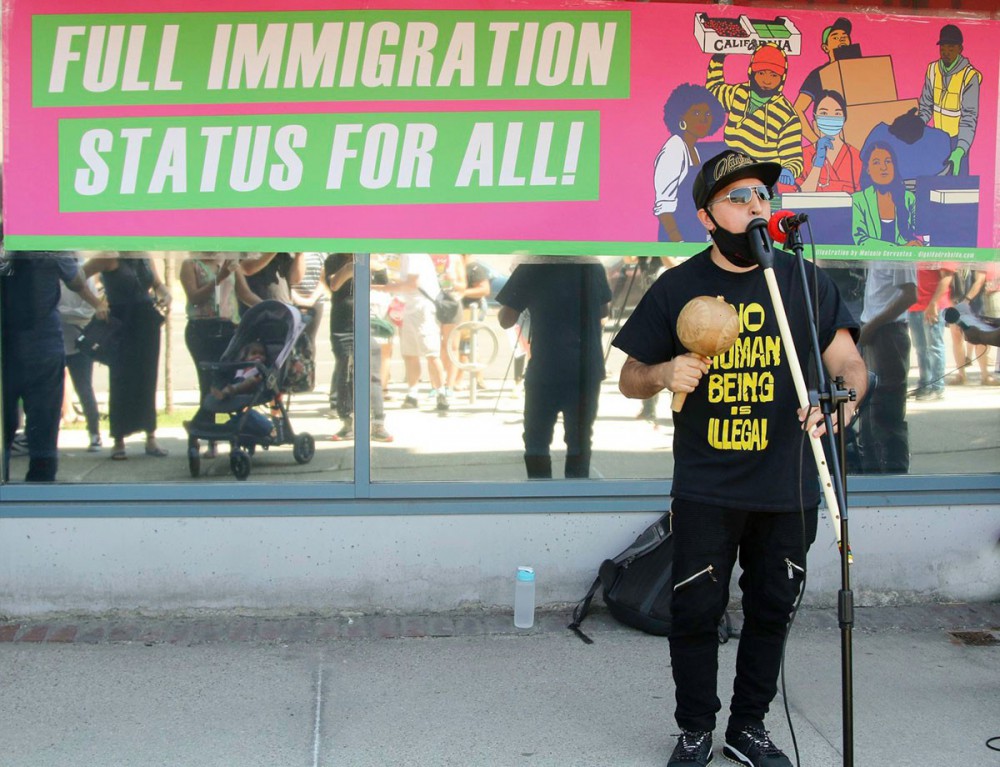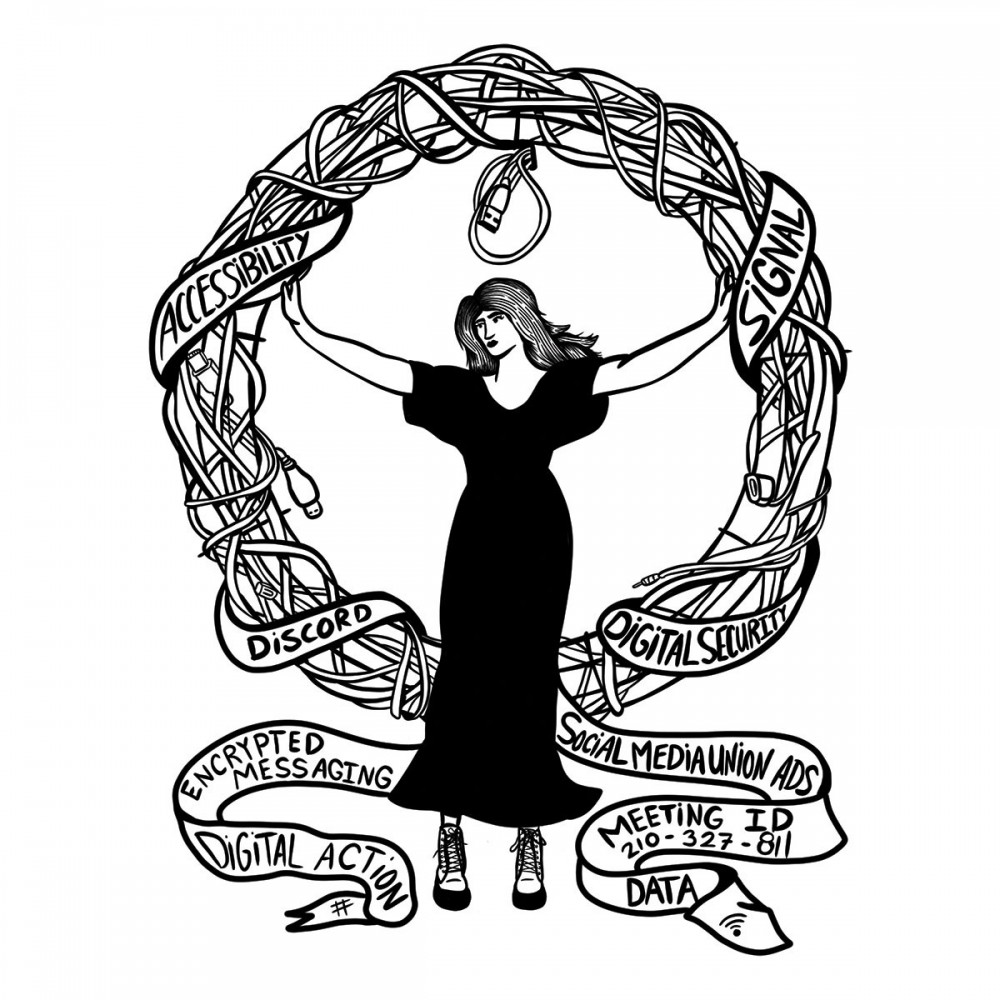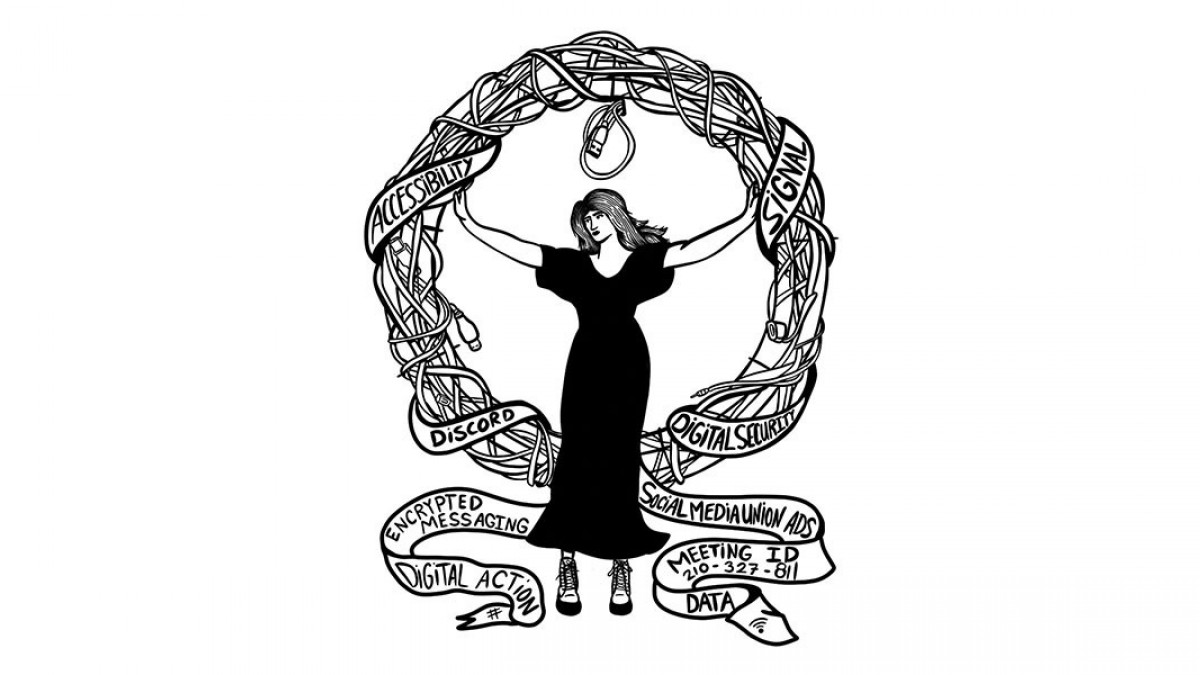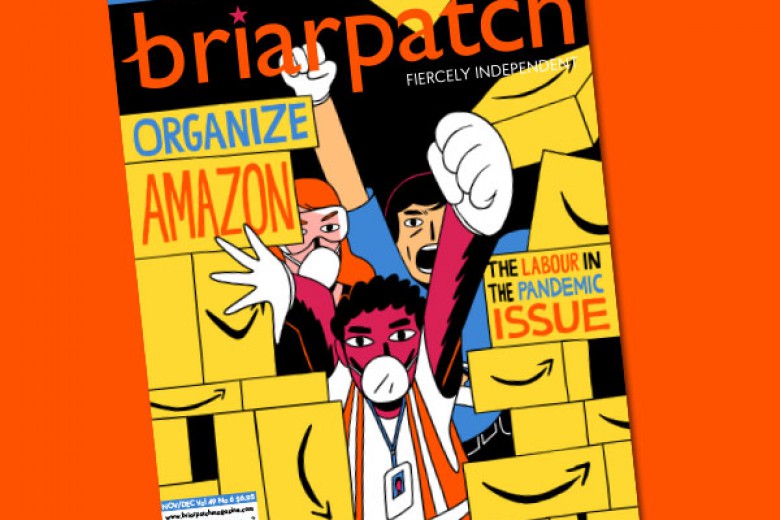On a hot July afternoon in the middle of the pandemic, Beny Esguerra performed with his kuisi bunsi flute at a rally outside the minister of immigration’s constituency office in Toronto. There, protesters demanded full immigration status for all migrants – a necessary measure during a pandemic that had already taken the lives of three migrant farm workers.
Esguerra and his flute are a regular fixture at migrant workers’ solidarity events. The kuisi bunsi originated over 2,000 years ago with the Indigenous Kogi people in present-day Colombia. Esguerra, a Juno-nominated musician and the child of political refugees, seeks to create a “new tradition” by combining Colombian rhythms with contemporary hip-hop.

Esguerra often pairs the ancient flute with an electronic loop station – a pedal-operated instrument that allows him to layer rhythms while engaging audiences in call and response. This coupling began with Esguerra trying to figure out how to perform at rallies when it wasn’t possible to have the backing of a band, proving once again that necessity is the mother of invention.
In this time of compounding health, economic, and environmental crises, labour activists have a critical role to play in all three. But we have to reinvent ourselves if we want to build working-class movements powerful enough to put the brakes on capitalism’s death drive. Unions need to put forward a compelling vision of how we intend to build power for all workers. We cannot turn inward in hopes of defending the shrinking gains of the minority of workers who are already unionized. We need to make a hard break with top-down business unionism by recommitting to organizing the unorganized through inclusive, high-participation, worker-led campaigns that fight for the common good.
Esguerra’s “new tradition” concept offers a useful framework for us to reimagine our efforts. “To create something new, you have to know where you came from: your past, your roots, and the struggle of your ancestors,” explains Esguerra. “You have to study in order to contribute new elements and fuse it with other styles.” Taking Esguerra’s lead, we might ask: how can we combine the best of our traditions with new approaches to labour organizing that respond to the changing realities of work?
Charting uneven recoveries
Capitalist economic growth is driven by the exploitation of land and labour, borne disproportionately by Indigenous, Black, and racialized bodies, by women and trans people, and by queer, disabled, and other oppressed groups. And that’s in the “good” times; when the economy contracts, like during the current pandemic, existing inequalities are magnified while well-positioned corporations like Amazon and Walmart reap massive profits.
“Businesses will be trying to cut costs, more workers will be doing side hustles to supplement their incomes, and consumers will want better value for their money. That suggests there will be another rise in precarious employment.”
Progressive economist Armine Yalnizyan notes that recessions tend to be followed by uneven recoveries marked by increasingly precarious employment. “In the wake of the 1981–82 recession, we hemorrhaged full-time work and part-time jobs ballooned. In the 1990s, the public and private sectors downsized, and net job growth came from self-employment, which is another form of precarity. After the 2008 crisis, temp agency and casual, on-call work grew,” she tells Briarpatch.
“For economic recovery reasons, businesses will be trying to cut costs, more workers will be doing side hustles to supplement their incomes, and consumers will want better value for their money. That suggests there will be another rise in precarious employment,” adds Yalnizyan. With the mainstreaming of precarity, labour activists need to learn from excluded workers who have long been organizing to address their lack of labour protections and access to unions.
Remembering community unionism
In the recession of the early 1990s, Deena Ladd was involved with efforts to explore different models of trade unionism. Ladd, who was working at the International Ladies’ Garment Workers’ Union (ILGWU), saw how economic restructuring was rapidly transforming their members’ working conditions.
A free trade agreement with the United States had come into effect and jobs in the historic garment district on Spadina Avenue in Toronto were disappearing – the work moving to Buffalo, the southern United States, and eventually to maquiladoras (foreign-owned companies with sweatshop conditions operating in duty-free export zones in Latin America).
Back in Canada, an old form of precarious work was re-emerging in place of garment factory jobs: subcontracted home-based work, paid by the piece. This shift gave employers a more competitive footing by undercutting hard-fought standards won by workers, much like today’s “gig economy.”
“I know I’m being underpaid, but there is nothing I can do. If I don’t do it, someone else will. The boss knows where to get cheap labour.”
A 1991 survey found that 21 of 30 Chinese immigrant women homeworkers were making less than minimum wage. They supplied their own industrial sewing machines, reported working an average of 46 hours per week – and often worked as many as 70 hours per week during busy periods – while assuming primary responsibility for their children at home. None of their employers made employment insurance or Canada Pension Plan contributions. Only one worker received the vacation pay to which they were entitled. In response to these dire conditions, one homeworker commented, “I know I’m being underpaid, but there is nothing I can do. If I don’t do it, someone else will. The boss knows where to get cheap labour.”
The unionization rate in the garment sector dropped from about 80 per cent in the 1970s to 20 per cent in the 1990s, prompting Ladd to note that “unionized factory jobs are leaving Canada, but maquiladora working conditions are also moving north.”
The union decided to follow the workers. First, this meant securing funding to create retraining programs for the older European, Chinese, and Black workers who suddenly found themselves unemployed. Next they had to develop organizing strategies to respond to the phenomenon of home-based work and the needs of the immigrant women sewing garments from their residences.

The ILGWU formed a Homeworkers’ Association (HWA) and made them an associate local. Organizers inverted the process for a union drive in a traditional workplace, which aims to form a union after securing legal certification with the support of a majority of workers. Instead of using the industrial certification model – developed for a single factory with a full-time, permanent workforce – the HWA used a creative approach better suited to a diffuse, subcontracted workforce with fly-by-night employers, no common place of work, and little contact with established unions.
Their model saw the HWA offer English classes at their office in Chinatown, provide child care so that workers could participate in meetings, and organize outings on weekends to help break their social isolation. This holistic approach, in which union organizing was inseparable from community organizing, came to be known as community unionism. While refreshing, the strategy was not entirely new. According to labour studies professor Simon Black, community unionism recalls a time when early, less bureaucratic unions “were much more rooted in the daily lives of workers and their families outside the workplace.”
The HWA used a creative approach better suited to a diffuse, subcontracted workforce with fly-by-night employers, no common place of work, and little contact with established unions.
Local homeworker organizing scaled up through a coalition to change provincial labour laws and efforts to build global alliances. In 1993, the HWA organized a panel with homeworkers from the United States and Mexico at the Labor Notes conference in Detroit. They also joined HomeNet, a global network of women-led organizations. In 1996, their advocacy led to the passage of an International Labour Organization convention on protecting the rights of home-based workers.
Organizing the unorganized
Sadly, in 1997 the leadership of the garment workers’ union pulled their support for homeworkers and other low-wage workers, whom they deemed too difficult to organize. But Ladd, who is now executive director of Toronto’s Workers’ Action Centre (WAC), credits the HWA with being a formative step toward the development of Toronto Organizing for Fair Employment (TOFFE), a precursor to WAC. Starting in 2000, TOFFE brought together groups of precarious workers – primarily immigrant women – based on a shared need for collective action. “All this work was disappearing from the mainstream into the margins, but no one was organizing these new forms of work,” says Ladd.
The worker centre model was first popularized in the late 1970s and early 1980s in the United States by labour activists who self-organized their communities in response to racism, poor working conditions, wage theft, and anti-union legislation that made conventional organizing especially difficult.
With limited financial resources, WAC has punched above its weight by leveraging the collective strength of low-wage workers. Through its Fight for $15 & Fairness campaign, WAC trained hundreds of new volunteer organizers, mobilized tens of thousands of people to take action in their communities, and set the terms of the public conversation on decent work in Ontario. Their efforts secured legislation that guaranteed a $15 minimum wage and paid sick days for all workers in 2017 – until Doug Ford’s newly elected Conservative government rolled back these commitments the following year.
“The so-called gig economy is just a continuation of age-old ways in which employers try to evade their responsibilities. ... Employers want to download risks onto workers and make it harder for them to organize.”
Like the retraining programs that “reached back” for unemployed garment workers in the 1990s, Ladd sees the difficult circumstances of the pandemic as a “moment to build stronger relationships.” WAC has provided regular webinars in English and Spanish on workers’ rights during COVID-19 and distributed over $100,000 in direct income support and food boxes. At the same time, WAC has joined with other organizations to push for policy interventions at the federal level, including paid sick days and income supports for all workers.
Precarious work is increasingly ubiquitous, with the advent of apps like Uber, Lyft, Foodora, DoorDash, and Instacart building their business models around misclassifying workers as independent contractors to avoid labour regulations. Ladd worries that the recent focus on app-based work runs the risk of ignoring the commonalities faced by all low-wage workers.
“The so-called gig economy is just a continuation of age-old ways in which employers try to evade their responsibilities,” says Ladd. “We saw that with the move to home-based work in the garment industry, with the rise of temp agencies, and with [the] contracting out of services like cleaning. Employers want to download risks onto workers and make it harder for them to organize.” She highlights the organizing drive by Foodora couriers with the Canadian Union of Postal Workers (CUPW) as a campaign that fought for the right of couriers to unionize while making links with other precarious workers who are denied access to labour protections.
Whole worker organizing
CUPW’s Justice for Foodora Couriers campaign built on the union’s own history with community unionism: an effort beginning in 1980 to unionize 6,000 rural and suburban mail carriers across Canada, which involved forming a pre-union association to advocate on behalf of workers. Like app-based couriers today, rural and suburban mail carriers supplied their own vehicles, lacked a central work site, and were misclassified until 2004, when they finally gained union recognition and employee status.
CUPW organizer Liisa Schofield explains that the Foodora union drive was initiated by couriers who started to meet among themselves. When approached for support, CUPW agreed to revive their bike messenger local in the winter of 2019 so that couriers could maintain a sense of ownership and build a worker-led steward network. As it turned out, a bottom-up organizing approach was not just a matter of shared values, but a necessity given the scale of their undertaking.
To reach hundreds of delivery drivers and bike riders scattered across Toronto and Mississauga, the organizing team conducted constant “ride-along” outreach over their workdays, offered advice to new workers, and hosted clinics on a range of topics. “The biggest challenge – more than scale or geography – is the conditions of life. It’s hard to ask more of someone when they are already working seven days a week, hustling from one job to another to support a family at home and possibly also family overseas,” says Schofield, who had previously organized with the Ontario Coalition Against Poverty.
Sarom Rho, who worked for Foodora and was a key part of the campaign, names “whole worker organizing” as an important part of their approach. In her book No Shortcuts, union organizer Jane McAlevey describes this strategy as recognizing the connection between the politics of work and politics of community. “A one-dimensional view of workers as workers rather than as whole people limits good organizing,” she writes.
“We mapped out workers to see how else we could reach them and support their needs, beyond just immediate workplace concerns,” says Rho, who also organizes with the Migrant Workers Alliance for Change. She noticed that a lot of migrant students in Peel Region were commuting to work downtown, where there were more orders. “For migrant workers, it’s not just about pay, but also whether the union is willing to take a stand on other issues that affect us, like immigration. When unions support the call for status for all, we are more likely to feel like we have a place in the union,” says Rho.
“Couriers are building a sense of community,” adds Schofield. “When people feel supported, they bring other aspects of their lives to the table, and that shifts the dynamic. We’re seeing that now with the drivers committee. Drivers are delivering masks and food boxes on their own time to fellow couriers during the pandemic.”
“When people feel supported, they bring other aspects of their lives to the table, and that shifts the dynamic."
Foodora abruptly announced that they were exiting the Canadian market in May. This decision came in the middle of the COVID-19 crisis and mere months after the Ontario Labour Relations Board issued a precedent-setting decision recognizing the right of the app-based couriers to unionize. “With the company leaving, migrant and racialized members are stepping up. Their leadership is the result of months of work. Having a union provided a space for them to speak up, be heard, issue demands to the company, and take part in mutual aid efforts,” says Rho.
“Couriers have voted to continue organizing and CUPW has committed to continue to support them,” says Schofield. “There’s interest in broader gig worker organizing, since it’s common for people to be working for multiple apps at the same time. Couriers are also interested in coalition-building to lay the groundwork for changing legislation.” She points to gig workers in California who won the Assembly Bill 5 law to correct misclassification, and the work of the $15 & Fairness campaign in Ontario as their sources of inspiration.
Taking bold risks
When the pandemic hit, many unions scrambled to adopt new digital tools like Zoom. But there was a time when trade unionists were ahead of the technological curve. For the past 20 years, Derek Blackadder has volunteered with LabourStart, an online platform for working-class solidarity that launched in 1998. LabourStart began doing online actions targeting decision makers in labour disputes with software that labour activists coded themselves.
“Employers didn’t know what to do with an inbox full of email. It was novel and had an impact,” says Blackadder, a former union staff representative. The LabourStart team offered their software to unions free of charge, but Blackadder says “few if any” took their suggestion to build their own digital organizing capacities.
Unions preferred to reach out to LabourStart, a relatively tiny, volunteer-run endeavour, to request support when a campaign emerged. This effectively “short-circuited the organizing benefit of unions doing it themselves,” says Blackadder, the project’s coordinator in Canada. LabourStart now has a global email list with 180,000 subscribers, more than many unions and labour federations with far greater resources.
He explains that unions’ hesitation came partly from their reluctance to take risks when they are “constantly putting out fires.” In an interview with Talking Radical Radio, Blackadder tells host Scott Neigh, “Figuring out ways to use technology in movements requires a willingness to experiment and to get it wrong.” Another barrier is political in nature. “If unions adopted tech the way workplace activists wanted, it would increase democratic participation in our unions and it would also create a less predictable environment for union leadership,” Blackadder tells Briarpatch.
Technology can provide new avenues for member involvement and increase transparency, but it can also do the opposite. In efforts to streamline their operations, some unions have opted for a “member resource centre” model, where a call centre becomes the preferred point of contact. Member resource centres are staffed by labour relations generalists and are dependent on expensive database software. Rank-and-file workplace reps – who would typically handle these calls in-person – are sidelined, along with the institutional knowledge they hold and personal relationships they maintain. This kind of “modernization” undermines the democratic structures of unions.
Blackadder says he saw the COVID-19 crisis “thrust a kind of tech democracy on trade unions.” Labour councils and large unions like CUPE, Unifor, UFCW, and OPSEU started to use Zoom for membership meetings. Many saw attendance numbers go up. “Physically attending meetings is a barrier for some members, particularly women and caregivers. Email and social media made it possible for members to participate to some extent on their own terms without coming to a meeting. Now it’s possible for the first time since 1946 for a union member sitting at home to meaningfully interact with their union,” says Blackadder in his conversation with Neigh.
“If unions adopted tech the way workplace activists wanted, it would increase democratic participation in our unions and it would also create a less predictable environment for union leadership.”
In 1946, a legal precedent known as the Rand formula gave Canadian unions the right to have their dues automatically deducted from paycheques. It also addressed the issue of “free riders” by ensuring that every worker who benefited from collective bargaining contributed to its costs. Before this, dues were paid directly by union members, ensuring a close level of contact between workers and union reps, which sometimes included reps visiting workers at home. The Rand formula provided unions with greater financial stability, but it came at a cost. The ruling reshaped the relationship between members and their unions and solidified a more legalistic approach to trade unionism by establishing severe financial penalties for unauthorized work stoppages.
At a time of intense social and economic upheaval, Blackadder’s experiences offer an important lesson for labour organizers today: our future is being shaped by changing structural conditions, but also by how we choose to respond to them. Unions can come out of the pandemic as more relevant and effective organizations by rediscovering their roots as worker-led movements. Democratic and egalitarian union cultures are our greatest source of strength when it comes to challenging corporate power.
Back in the 1990s, the rapid shift from “standard employment” to outsourced garment work signalled a larger economic transformation, one which reverberates in today’s gig economy. As the sphere of precarity swells, we must learn from the trailblazing efforts of workers on the front lines of these changes. Just like digital organizing, community unionism, worker centres, and whole worker organizing are living traditions. By arming ourselves with these innovative approaches and others like them, we can build on past efforts and experiment with new models for building worker power in these uncertain times.









